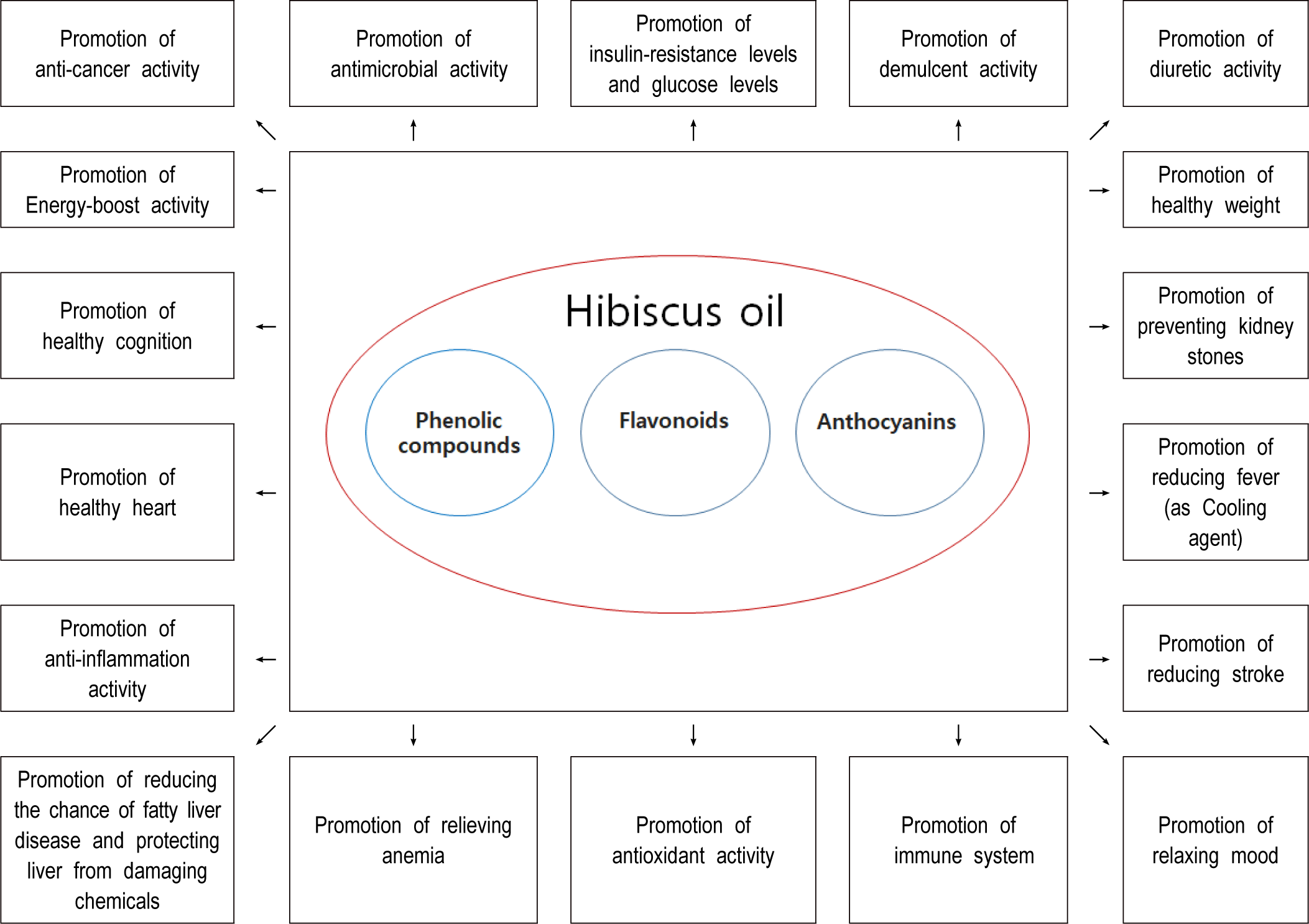Introduction
The interest of the people in upgrading health through more environmentally friendly methods has increased rapidly over the past decades, which has led to a lot of research into traditional therapies as resources of elements with biofunctional characteristics [1]. In particular, this is because various vegetable have long been widely used not only for nutritional purposes but also for medical purposes [1,2]. Therefore, these components extracted from various vegetable are recognized as a resource of important biofunctional components [1,2].
As far as is known, hibiscus contained a lot of various biofunctional compounds that could be applied to the development of biofunctional products, and the genus of hibiscus has more than 250 species [3–6]. As far as is known, hibiscus belonged to the Malvaceae family and was a genus of flowering plants [3–6]. Also, the origin of hibiscus is recognized as tropical Africa and Asia, and is currently cultivated in tropical regions such as Brazil, India, Hawaii, and so on [3–6].
Various studies have shown that the wide range of medicinal activity of vegetable- derived biofunctional materials was due to the several compounds (dietary fibers, minerals, secondary metabolites of vegetable, vitamins, and so on) [7]. Among various substances, phenolic materials were considered to be the largest group of vegetable 2nd metabolites and were also recognized as a part of biofunctional materials of great interest [7]. Fig. 1 summarized in detail the various biofunctional activities of hibiscus oil reported through many studies so far [1–7].
Functional foods are the most rapidly emerging and attracting attention in recent years [8]. In other words, the main interest of the beverage industry is rapidly shifting toward enhancing nutritional value as well as enriching food functions [8,9]. So far, in order to make food with biofunctional activity, the main raw material having a specific functional ingredients is directly added to the food without any treatment, or the desired ingredients is extracted from the main raw material through various ways and then added to food [8–10]. Among various beverages, cow’s milk is recognized as a perfect food that helps improve health by providing major and minor nutrients [11]. But, the number of people who cannot consume milk is increasing due to various problems such as specific regions where milk is not available, lactose intolerance & allergies due to milk intake, specific diseases that require stopping milk intake, and so on [8,10,11]. Therefore, although the nutritional value is slightly lower than that of milk, various vegetable-based milk analogues similar to the properties of milk have recently attracted attention as a substitutes [10,11]. For these various reasons, studies on vegetable-based milk analogues that are beneficial to health are being actively conducted [12]. Analysis of the market of vegetable-based milk analogues showed that cocoa milk, coconut milk, hemp milk, multigrain milk, oat milk, soy milk account for most of the market [8–13].
Therefore, due to the above-mentioned excellent advantages of hibiscus oil and the rapid increase in interest in various milk substitutes, research on improving various biofunctional activities by directly adding hibiscus oil to vegetable-based milk analogues is urgently required. But, after direct supplement of hibiscus oil to various vegetable- based milk analogues, studies on its organoleptic quality properties are still lacking.
Consequently, the goal of this study was to analyze organoleptic quality attributes of three different types of vegetable-based milk analogues supplemented with hibiscus oil at 0%, 0.25%, 0.5%, 1.0%, and 1.5%, respectively.
Materials and Methods
Edible hibiscus oil (Hibiscus Oil-Soluble Extract) produced by Amoretti (USA) was purchased, and then hibiscus oil was supplemented to three different types of vegetable-based milk analogues at 0%, 0.25%, 0.5%, 1.0%, and 1.5%, respectively. Then three different types of vegetable-based milk analogues containing hibiscus oil were kept in a refrigerator until evaluation. Three different types of vegetable-based milk analogues used in this study were purchased from the wholesale mart [14].
The pH’s scale of three different types of vegetable-based milk analogues supplemented with hibiscus oil with different concentration (at 0%, 0.25%, 0.5%, 1.0%, and 1.5%, respectively), were analyzed by using pH meter (Orion Star™ A211 Benchtop pH Meter, Thermo Fisher Scientific, USA).
A panel of five assessors determined the organoleptic quality attributes of three different types of vegetable-based milk analogues supplemented with hibiscus oil. This study was conducted in the same way as the previous study [14]. In other words, the organoleptic quality attributes of three different types of vegetable-based milk analogues supplemented with hibiscus oil was determined on a 5-point hedonism scale, and the items consisted of four parts (overall acceptability, flavor, color, and texture, respectively).
The evaluation data of organoleptic quality attributes of three different types of vegetable-based milk analogues supplemented with hibiscus oil collected in this study were analyzed with a statistical analysis program (GraphPad Prism 5, GraphPad Softward, USA) at a significance level of 95%.
Results and Discussion
On the pH’s scale, hibiscus oil was approximately 4.2, almond milk was 6.75, oat milk was 7.30, and soy milk was 8.49, respectively (Fig. 2). In addition, hibiscus oil was added to three different types of vegetable-based milk analogues at 0%, 0.25%, 0.5%, 1.0%, and 1.5%, respectively, and the pH’s scale was investigated. According to the statistical analysis results, no significant difference was observed between the control group and the treatment group (with the addition of hibiscus oil) on the pH’s scale (Fig. 2). The results of the pH’s scale obtained in this study showed similar tendencies to previous studies [14]. In other words, it is considered that the addition of oil does not affect the pH’s scale of vegetable-based milk analogues products.
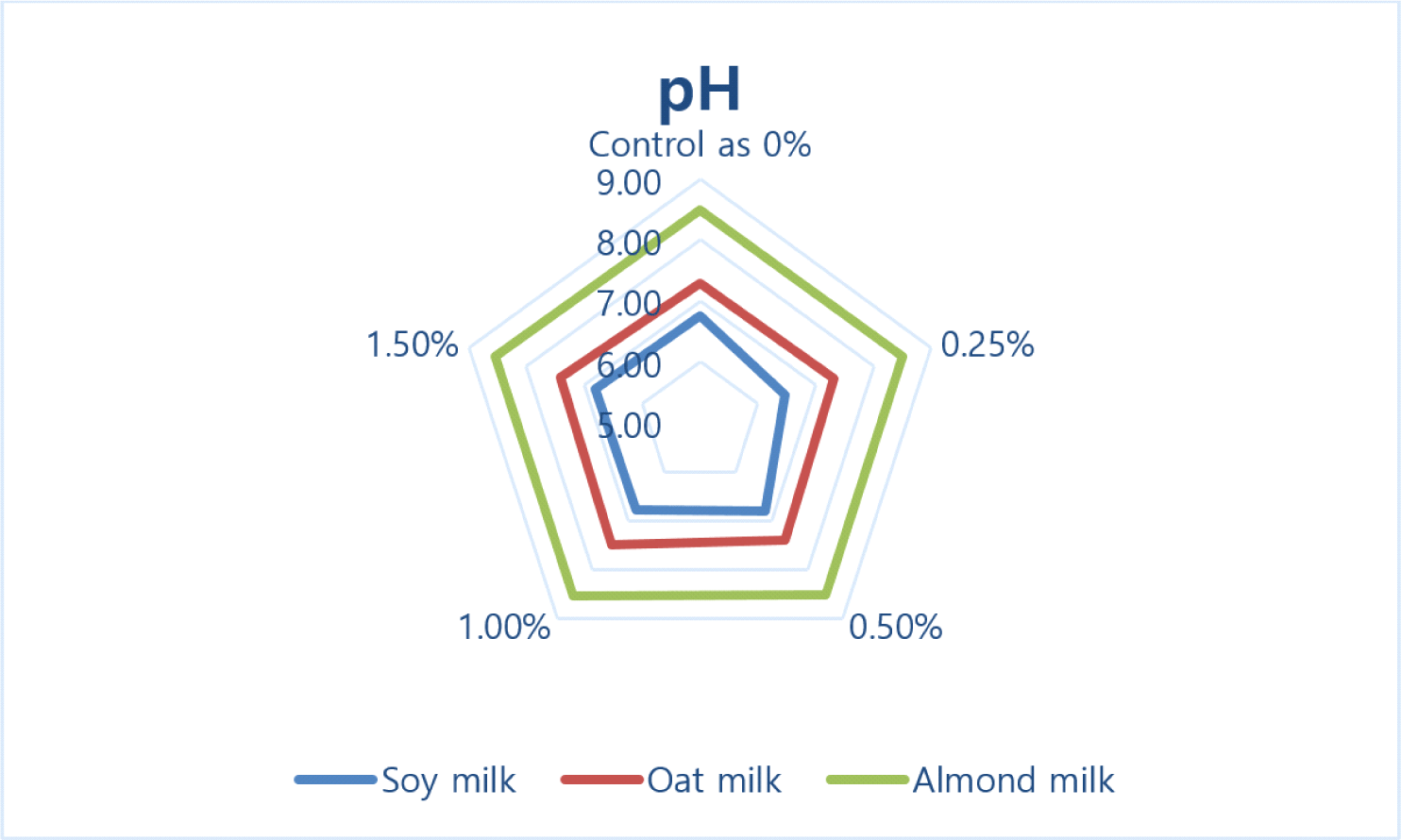
The organoleptic quality attributes of hibiscus oil supplemented to three different types of vegetable-based milk analogues evaluated by a panel of five assessors were as follows. The composition of a panel of five assessors was food-related majors with a master’s degree or higher, and also those who have received training on the evaluation of the organoleptic quality attributes.
Soy milk was shown in Fig. 3, oat milk was shown in Fig. 4, and almond milk was shown in Fig. 5, respectively. Different concentrations of hibiscus oil were added to three different types of vegetable-based milk analogues at 0%, 0.25%, 0.5%, 1.0%, and 1.5%, respectively.
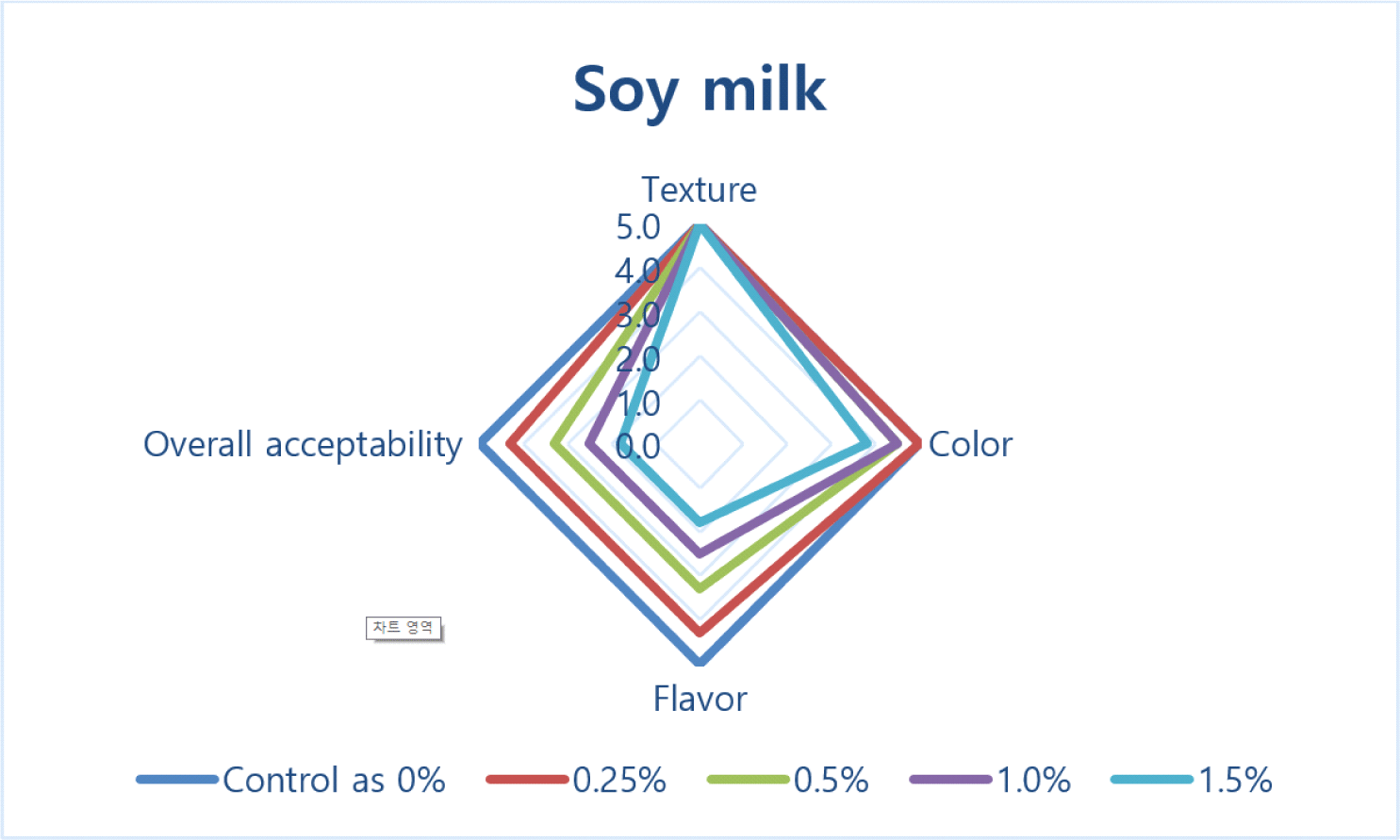
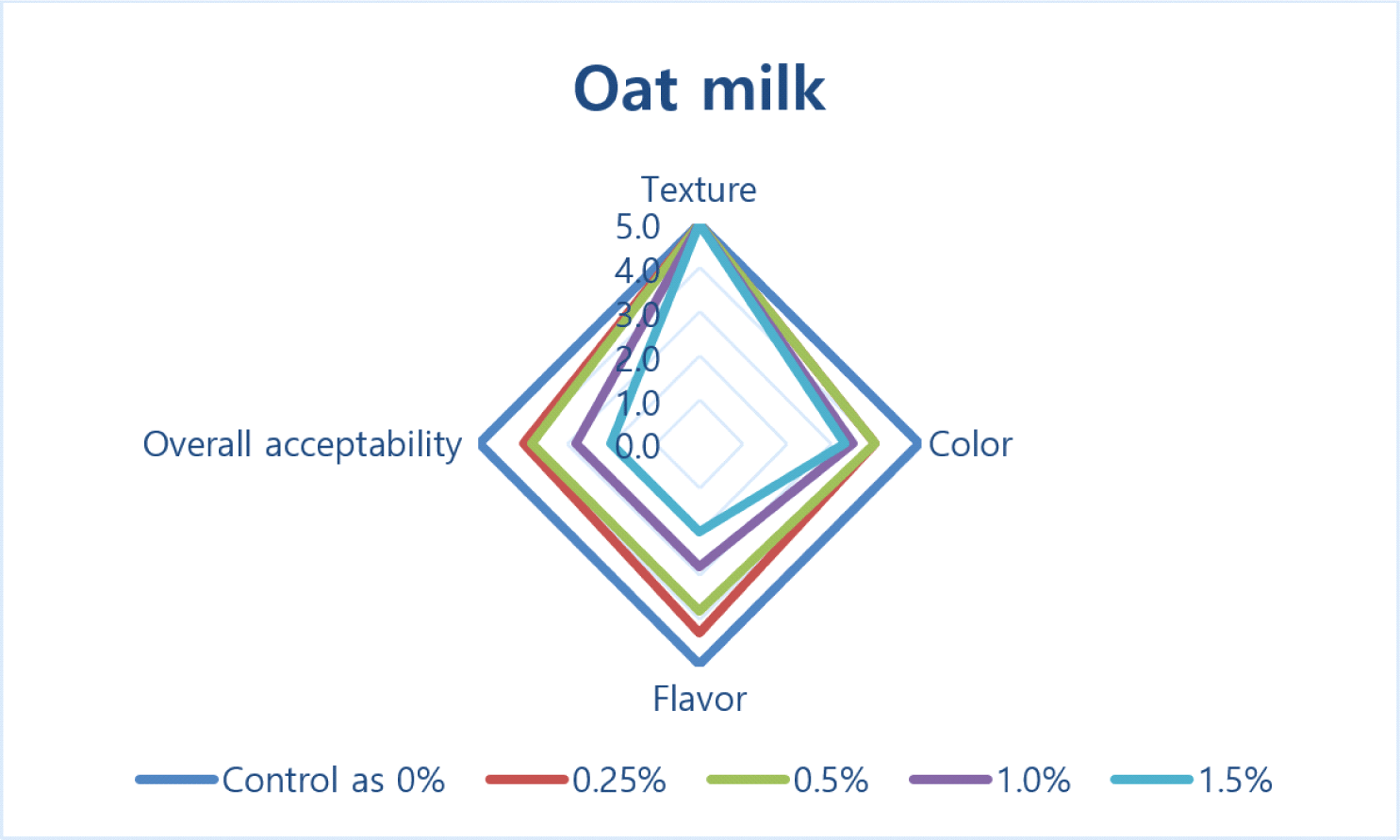
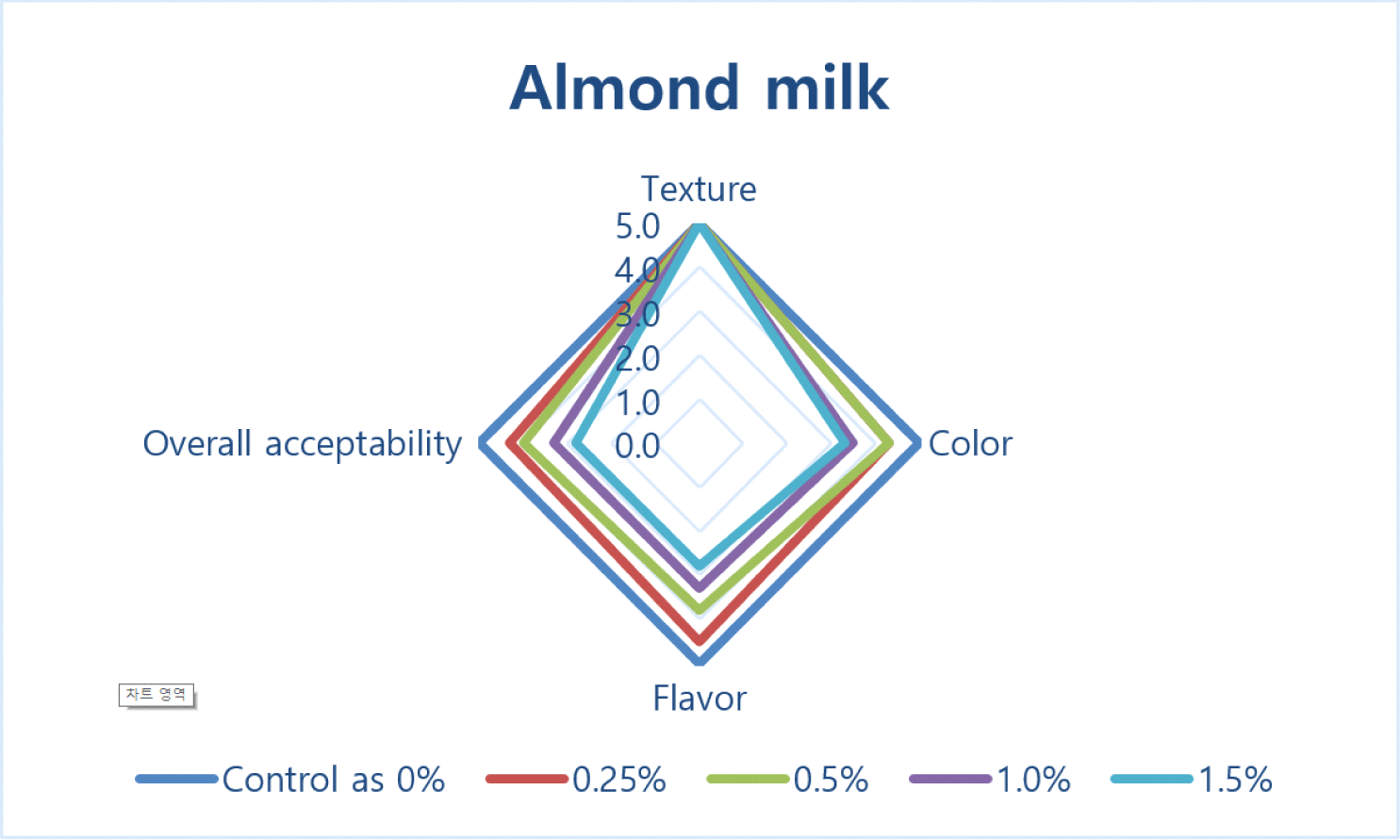
As a result of statistical analysis of the sensory quality attributes of three different types of vegetable-based milk analogues, overall acceptability, flavor, and color showed statistically significant differences between the control group and the treatment group (with the addition of hibiscus oil from 0.25% to 1.5%; p<0.05). However, texture did not show any statistical significance.
In detail, as the supplemental concentrations of hibiscus oil increased, the organoleptic quality attributes of the overall acceptability, flavor, and color excluding texture, showed a pattern of overall decrease (Figs. 3–5).
Therefore, in the organoleptic quality attributes investigated in this study, the best results were shown three different types of vegetable-based milk analogues when the supplemented concentrations of hibiscus oil added was 0.25%.
Also, the pattern of color change of three different types of vegetable-based milk analogues in which hibiscus oil was supplemented at concentrations ranging from 0.25% to 1.5% were shown in Fig. 6.
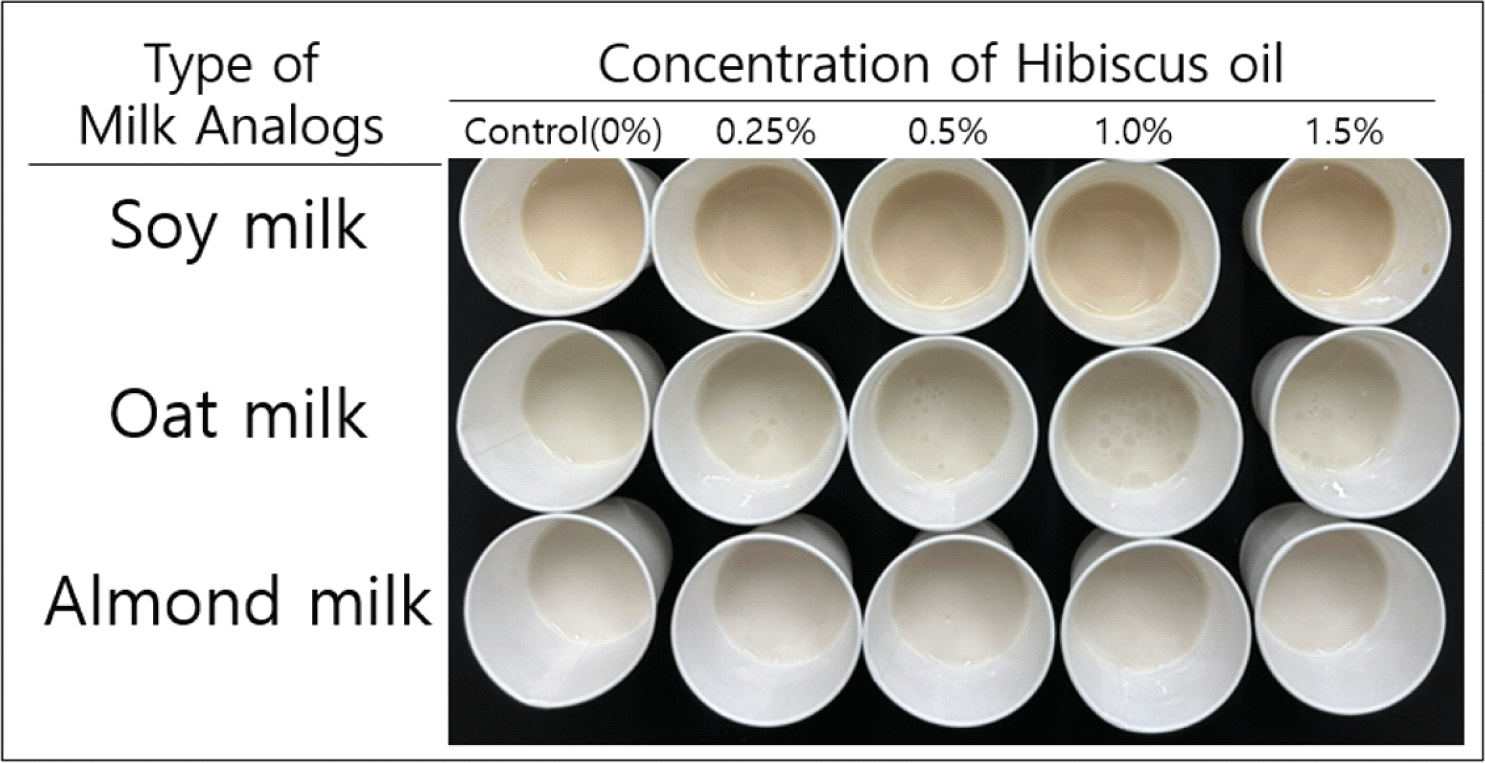
The detailed comments of a panel of five assessors who participated in the organoleptic quality attributes of three different types of vegetable-based milk analogues of this study were summarized as follows. When hibiscus oil was added to three different types of vegetable-based milk analogues with weak sweetness (soy milk, oat milk, and almond milk), the match was somewhat lacking. In particular, the flavor of hibiscus oil, such as vegetable oil, was rather strong, so it is considered that it did not receive a good evaluation in terms of flavor and taste when mixed three different types of vegetable-based milk analogues. Therefore, additional research should be conducted to fundamentally resolve the above-mentioned opinion. Despite these results, this is the first study to evaluate the organoleptic quality attributes by supplementing hibiscus oil to three different types of vegetable-based milk analogues (soy milk, oat milk, and almond milk).
In this study, the organoleptic quality attributes was observed by directly supplementing hibiscus oil to three different types of vegetable-based milk analogues without using emulsifiers. For this reason, research on the selection of the most appropriate emulsifier should be conducted so that hibiscus oil could be uniformly mixed with the three different types of vegetable-based milk analogues, and also so that hibiscus oil can be commercially used. Nevertheless, this study could be used as basic data for research related to hibiscus oil.
The industrial making of biofunctional foods contained the combination of biofunctional materials isolated from vegetable species so as to improve the organoleptic quality attributes (texture, flavor, color, and so on) and also provided several health- uplifting impacts [15,16]. However, if vegetable-derived biofunctional materials are exposed to various unfavorable processing environment (e.g., light, oxygen pH, temperatures, and so on), they would be often processed in an unstable state [15,17]. After all, for these various reasons, industrial production of biofunctional elements isolated from vegetable is not easy. The integration of extracts affluent in encapsulated biofunctional materials isolated from vegetable of the genus Hibiscus in food mixture could be considered as a prospective option for upgrading the stabilization of food systems and for activating the new development of biofunctional products [15,16].
Furthermore, studies on the various biofunctional characteristics of these elements (eg, antibacterial, anti-inflammatory, antihypertensive effects, antioxidant, and so on) have been conducted, and it is also evaluated that these elements have many possibility applicable to the cosmetic, food, pharmaceutical industries, and so on [18,19].
Most of vegetable-based milk analogues were produced by limited fermentation in order to maintain various biofunctional activities [20]. According to recent reports of various studies, vegetable-based milk analogues had a positive correlation with improving health and preventing disease, and these results were known as supplemented biofunctional-boosting ingredients [8–15]. In particular, one of the main advantages of vegetable-based milk analogues over animal milk had a much lower energy input per unit of milk produced than animal milk, and furthermore, the composition of biofunctional materials could be easily changed according to various consumer’s demands [8]. But, consumer acceptance of vegetable-based milk analogues would depend on solving key limiting factors, such as the limitations of production technology and also unsatisfaction of organoleptic quality attributes [8,16,17]. Hence, for resolving these major problems mentioned above, it is necessary for both the food companies and food-related researchers to work together so as to produce newly developed vegetable- based milk analogues with both upgraded biofunctional activities and suitable for various needs of consumers.

